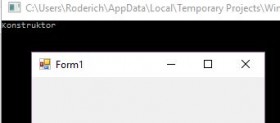Ich hab da einen blöden Effekt entdeckt, reproduziert mit VS2010 und VB2013, in VB und in C#.
Da das ggf. von allgemeinem Interesse ist, pack ich das zu den Tipps und Tricks rein.
Folgender einfacher Code:

Dies funktioniert im beim Debuggen im Studio nur, so lange diese Checkbox aktiv ist:

wird sie deaktiviert, bleibt die Console leer.
Beim Start von der Festplatte, ohne den vsHost-Prozess, funktioniert alles wie gehabt.
Da das ggf. von allgemeinem Interesse ist, pack ich das zu den Tipps und Tricks rein.
Folgender einfacher Code:
Dies funktioniert im beim Debuggen im Studio nur, so lange diese Checkbox aktiv ist:
wird sie deaktiviert, bleibt die Console leer.
Beim Start von der Festplatte, ohne den vsHost-Prozess, funktioniert alles wie gehabt.
Falls Du diesen Code kopierst, achte auf die C&P-Bremse.
Jede einzelne Zeile Deines Programms, die Du nicht explizit getestet hast, ist falsch
Ein guter .NET-Snippetkonverter (der ist verfügbar).
Programmierfragen über PN / Konversation werden ignoriert!
Jede einzelne Zeile Deines Programms, die Du nicht explizit getestet hast, ist falsch

Ein guter .NET-Snippetkonverter (der ist verfügbar).
Programmierfragen über PN / Konversation werden ignoriert!
